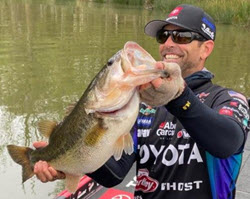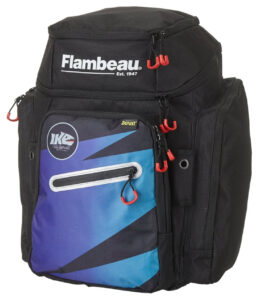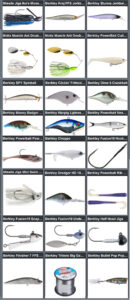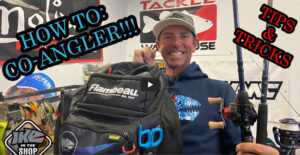
Co-angling is not a topic that you hear a lot about so let’s talk about how to prepare and get ready to be a co-angler in a bass tournament. In this blog we’re going to go over the basics; the tackle to carry, how to carry it, rods and reels, fishing techniques from the back of the boat and more.
Before we get into that, let me backup and tell you that in the early 90s, back when I was in my 20s, I was a co-angler. I was a co-angler for three years before I made the jump to start fishing on the boater side, and it was a great experience. It was a great learning opportunity where I learned a lot about fishing. So, if you’re reading and you’ve thought about becoming a co-angler, let me tell you, go do it! A lot of circuits out there—locally, regionally, B.A.S.S., Major League Fishing—have opportunities for co-anglers, even if you don’t have a boat. I’ve had a lot of co-anglers in the back of my boat over the years, so I have a perspective on how to be a good co-angler, watching it from the back, and what to do and what not to do.
Let’s start off with tackle and what to bring. The number one mistake co-anglers make is bringing too much or too little tackle. We want to aim for the middle when it comes to packing for a day of fishing as a co-angler. You don’t want three or four boxes and bags and 15-18 rods; that’s too much. But you also don’t want a little brown paper bag with one spinning rod either. A good balance is key.

I’m a big advocate of using a backpack or a tackle bag. There are a lot of great ones out there from different manufacturers. This Flambeau Ike Approved backpack is a great way to store your tackle because it lets you carry a moderate amount of equipment in one unit. Two to six rods is perfect for a co-angler; a mix of a few finesse rods (spinning rods) and a few casting rods (baitcasters) is all you need. Medium action spinning rods around seven to seven-and-a-half feet and medium to medium-heavy casting rods are ideal because they can handle a variety of techniques.
Next, let’s talk about what to pack in your bag. This backpack doesn’t weigh 100 pounds and doesn’t contain everything under the sun, but it has the essentials. Here’s a rule to follow: pack lures and baits that cover from the top to the bottom of the water column. Think about lures for the top zone (like walking baits, poppers, and buzzbaits), the middle zone (like spinnerbaits, chatterbaits, jerkbaits, and crankbaits), and the bottom (like drop shots, Ned rigs, finesse Carolina rigs, compact jigs, and Texas rig plastics). This way, you’ll be ready for any situation that the boater takes you to. Organize your lures in smaller boxes labeled by type (e.g., jerkbaits, crankbaits, topwaters) to keep things neat and accessible.

Now, let’s get into the mindset of being a co-angler. This part is crucial because when you get in that boat, it’s time to separate yourself from other co-anglers and catch fish from the back of the boat. The first variable is to always be a little different from what the guy in the front is doing. If he’s skipping docks and only fishing the outside, cast way back up to the walkways. If he’s flipping mats and only hitting the edges, go way back in. Also, be different with your lure selection. If he’s using a wacky rig, try a shaky head or a weightless fluke. However, if your boater is absolutely smashing them, match what he’s doing. This happens only about 10% of the time, though. Most of the time, being a little different will help you get more bites.
The second mindset tip is to think finesse. As a co-angler, you’re often fishing used water behind a really good angler. Using finesse techniques—like a drop shot, wacky rig, shaky head, Ned rig, or a finesse swimbait—can make a huge difference. Smaller lures, lighter line, and spinning rods are your best friends. Finesse techniques will get you bites and often big fish, too. Remember, you can still scale down your baits and weights if needed.
I hope you enjoyed these tips on preparing to be a co-angler. Remember, bring a moderate amount of stuff, simplify your tackle, think finesse, and pay attention to what your boater is doing. Good luck as a co-angler!______________________________

________________________
Like Ike on Facebook, and follow him on Instagram and TikTok for fishing and fun content.
Subscribe to Mike’s YouTube channel, to ensure you see every adventure video. (Download the YouTube app on your phone and the videos will come to you automatically.)
















